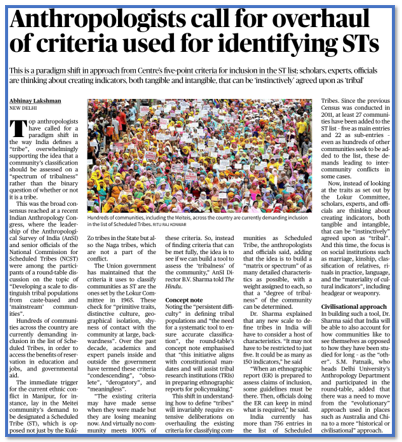Syllabus Mapping
GS Paper II: Governance, Constitution, Polity, Social Justice, and International Relations (Government policies and interventions for development, Welfare schemes for vulnerable sections, Issues relating to health and nutrition).
Introduction
• Nutrition is a fundamental determinant of public health and socio-economic development. Despite various schemes like Poshan 2.0 and Saksham Anganwadi, India continues to face significant nutrition-related challenges.
• Key Statistics (as per NFHS-5, 2019-21):
o 36% of children under five are stunted (low height-for-age).
o 19% of children are wasted (low weight-for-height).
o 32% of children are underweight.
o 57% of women aged 15-49 years are anaemic.
o 24% of women and 23% of men are overweight or obese.
o 14% of the population consumes diabetes medication.
Key Challenges in Addressing Nutrition
1. Socio-Economic and Geographic Disparities
• Rural-Urban Divide: Malnutrition rates are higher in rural areas compared to urban regions.
o Rural stunting: 37.3% vs. Urban stunting: 30.1% (NFHS-5).
• Regional Disparities: States like Bihar, Uttar Pradesh, and Jharkhand have stunting rates above 40%, whereas states like Kerala and Tamil Nadu have lower rates.
• Gender Disparities: Anaemia prevalence is higher among women (57%) compared to men (25%).
2. Implementation Gaps
• Health and Wellness Centres (HWCs), designed to provide nutrition services, are inconsistently implemented and unevenly distributed.
• Inconsistent Service Delivery: Only a fraction of HWCs systematically deliver nutritional advice and supplements.
• Inadequate Reach: Limited access to nutrition services in remote and aspirational districts.
3. Targeting Non-Communicable Diseases (NCDs)
• Increasing prevalence of lifestyle diseases due to poor dietary habits:
o 24% of women and 23% of men are overweight or obese.
o 14% of adults take medication for diabetes.
• Current nutrition schemes largely focus on maternal and child nutrition, neglecting NCDs.
4. Limited Local Engagement
• Nutrition interventions often fail to account for local dietary habits and cultural preferences.
• Lack of local leadership involvement in promoting nutrition awareness, leading to poor scheme penetration.
5. Resource Constraints
• Human Resource Gaps: Shortage of trained nutritionists, with many rural areas lacking adequate counseling services.
• Financial Constraints: Inadequate funding for schemes to ensure sustained nutrition coverage and monitoring.
Key Government Schemes Addressing Nutrition
1. Poshan 2.0 (Prime Minister’s Overarching Scheme for Holistic Nutrition):
o Focuses on improving nutritional outcomes for children, pregnant women, and lactating mothers.
o Targets aspirational districts and marginalized communities.
o Emphasizes community-based health monitoring and local dietary practices.
2. Saksham Anganwadi and POSHAN Abhiyaan:
o Strengthens Anganwadi centres for better delivery of nutrition services.
o Promotes early childhood care and development through integrated services.
o Utilizes technology for real-time monitoring and intervention.
3. Mid-Day Meal Scheme (PM-POSHAN):
o Provides nutritious meals to children in government and government-aided schools.
o Addresses classroom hunger and promotes school attendance.
4. Anemia Mukt Bharat (AMB):
o Targets the reduction of anemia among women, children, and adolescents.
o Focuses on Iron and Folic Acid supplementation, dietary diversification, and deworming.
5. Integrated Child Development Services (ICDS):
o Provides supplementary nutrition, pre-school education, and health check-ups for children under six and pregnant/lactating women.
6. National Health Mission (NHM):
o Focuses on strengthening health systems, including maternal and child health services.
o Works towards improving service delivery through health sub-centres and HWCs.
Way Forward
1. Comprehensive Nutrition Strategy
• Expand the scope of nutrition programs to cover all vulnerable groups, including elderly, men, and people with NCDs.
• Promote awareness on healthy eating practices, especially in urban areas.
2. Strengthen Institutional Framework
• Enhance the capacity of HWCs to ensure consistent and systematic delivery of nutritional services.
• Improve the training and recruitment of Anganwadi workers and nutritionists for better outreach.
3. Local Engagement and Solutions
• Empower local leaders and communities to promote awareness and design culturally relevant nutrition strategies.
• Encourage consumption of locally available, low-cost, and nutrient-rich foods.
4. Integrated Policy Framework
• Integrate nutrition initiatives with agricultural policies to promote the production of fortified crops.
• Ensure linkages between nutrition programs and education campaigns to build awareness.
5. Monitoring and Accountability
• Establish robust monitoring frameworks for assessing the impact and reach of nutrition schemes.
• Regularly evaluate and refine policies based on data-driven feedback and regional requirements.


